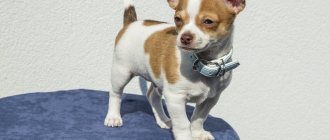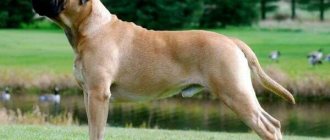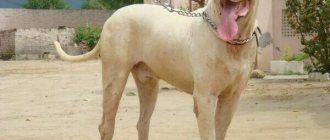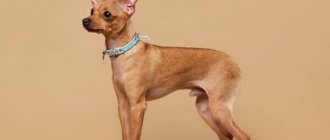Micro Chihuahuas are considered the smallest dogs in the world.
The height of some of them does not exceed 12 cm at the withers, and their weight can be 0.5 kg.
These are cute and very small creatures with a strong character.
They become pets and have many advantages.
What are the breed characteristics of the super mini Chihuahua and how should you care for such a pet?
Let's look into everything in detail.
Origin story
Micro-sized puppies were born in Techichi litters, which became the ancestors of the Chihuahua and lived in Mexico since the 15th century BC. to 16th century AD .
Read more about the history of the origin of the Chihuahua breed here.
When the Spaniards conquered Mesoamerica, they began to destroy the cultural heritage of Indian civilizations, and at the same time, the local dogs living at the temples also suffered.
Many Techichi died at the hands of the conquistadors, but a small part of the population managed to escape: the dogs fled into the forest and settled there near the ruins of Aztec cities.
Several centuries later, at the beginning of the 19th century, their descendants were noticed by local residents and, tamed, made them their pets.
And soon tourists from the United States, who liked these small, cute dogs, began to buy puppies from their pets from the Mexicans, among which, probably, there were also especially small animals.
The first breed standard limited the weight of Chihuahuas to 0.5-3 kg .
But too small sizes have long been considered undesirable, especially for females, since micro girls are not suitable for breeding. It is for this reason that such dogs were not in great demand at that time.
When it became fashionable not only to keep small dogs in the house, but also to take them everywhere with you, including to social events, everything changed. After all, a micro dog is easier to hold in your arms for quite a long time than a standard dog.
Micro Chihuahuas have never been deliberately bred . Such puppies are not born in every litter, and no experienced dog handler can predict whether such babies will be among the expected offspring or not.
Physical exercise
Low physical activity and size are the most important reasons to buy this breed. Your dog will need daily walks and that’s it, but it’s absolutely impossible without exercise.
- Newfoundland - history of the breed, education, care + 73 photos
Brussels Griffon - history, modern appearance, standards, character and content + 77 photos
Tibetan Mastiff - features of the breed and useful qualities of the shaggy big guy + 85 photos
If you do not want to help the animal satisfy its natural needs, be prepared for the aggressive behavior of your pet (barking, gnawed furniture).
Description and character
Micro Chihuahua is a very small, but at the same time stately dog . If such a dog has the correct structure, then it does not seem weak or too fragile.
By nature, micro Chihuahuas are energetic and cheerful.
They become very attached to their owners and often accompany them everywhere.
These affectionate dogs very subtly sense the mood of the owner and, as many people who have such pets live in their homes note, they understand them at a glance.
Like all other Chihuahuas, micros are brave and reckless . The owner needs to ensure that his tiny pet does not bully large dogs, cats or chase crows during a walk, as these animals may well cause him serious injury.
Proper feeding
The basis of feeding a mini Chihuahua, if it eats natural food, should be protein foods, such as chicken, veal or lamb..
Once a week, the meat can be replaced with sea fish, after boiling it and removing all the bones.
In addition to meat and fish, the diet should also include seasonal domestic fruits and vegetables, rice and buckwheat cereals in the form of thin porridges, lactic acid products and vegetable oils, such as sunflower or olive.
When feeding natural products, you should also include vitamin and mineral supplements in your dog’s diet and give it to your pet in courses.
You can feed mini Chihuahuas with high quality industrial food designed for the smallest dogs.
The food should be appropriate for the pet's age, physical condition and activity level. If the dog has health problems, it is recommended to feed it with special dietary food.
Marriage or breed?
Micro Chihuahuas are not considered a breed defect, but only if their weight is between 0.5 and 1 kg.
If the dog weighs less, then it is considered a defective breed and is subject to disqualification.
However, it must be taken into account that at exhibitions preference is still given to dogs weighing from 1.5 to 3 kg.
Expert opinion
Kozhevin Semyon Kirillovich
Expert dog handler.
“Micro Chihuahuas are touching and cute, and they are also very convenient to take with you to any event or on a trip. However, those who are thinking about purchasing such a small pet need to understand that these dogs are very gentle and fragile in the most literal sense of the word. Many micros have signs of dwarfism, which makes them prone to a variety of diseases, and their immunity is much weaker than that of standard dogs. And, of course, micro girls cannot participate in breeding.”
Where to buy, how much it costs
You should not buy a dog at a pet store or market, since the chance of acquiring a healthy and purebred one is extremely small. You should choose a specialized nursery with a good reputation:
- Pearl of dreams (Kuntsevo).
- Flower of Elves (Moscow).
- Astra Vitus (Moscow).
- Krokha-Dog (Moscow).
- Chintamani (Novouralsk).
- Lucky Beggar (Naberezhnye Chelny) and others.
The price for a mini-Chihuahua puppy starts from 20,000 rubles from private breeders and reaches 170,000 rubles in a nursery.
Advantages and disadvantages
pros
- Sweet and touching.
- They do not take up much space in the house or apartment.
- Sociable.
- Devoted.
- Despite their small size, they are very bold.
- Smart and savvy.
- Their coat is easy to care for.
- You can take such a small dog with you anywhere.
- They are easily accustomed to a tray or diaper.
Minuses
- Predisposed to many diseases.
- Micro Chihuahuas often experience injuries.
- In the absence of training, they become unauthorized.
- They should not be allowed to play with other animals or children.
- Prone to fights with other dogs.
- May experience feelings of jealousy.
- Doesn't get along too well with dogs of other breeds living in the house.
Micro girls are not allowed for breeding . The same applies to male dogs if their weight is less than 0.5 kg.
Animal diseases
Miniature Chihuahuas can be predisposed to a number of diseases, namely:
- Hydrocephalus.
- Epilepsy.
- Dysplasia.
- Rheumatism.
- Stenosis of the pulmonary trunk.
- Heart failure.
- Atrophy of the heart valves.
- Urolithiasis disease.
- Retinal atrophy.
- Cataract.
- Dermatitis.
- Demodecosis.
- Food allergies.
Chihuahuas are also prone to hypoglycemia, obesity, and dental and oral diseases..
Dimensions, weight and other distinctive features
Micro sizes are not specified in the standard. But, according to the breeders of this breed, they should not exceed 14 cm at the withers.
Weight ranges from 0.5 to 1 kg.
The body format of these dogs is close to square. The physique is strong, despite its tiny size, so that the dog looks squat and muscular.
The head is round, apple-shaped. The forehead is convex, the transition from it to the muzzle is pronounced. The muzzle is medium in length or somewhat shortened.
The teeth are small, but white and strong, with a scissor bite.
The eyes are large, dark, widely spaced.
The ears are large, erect, in the shape of a rounded triangle.
The neck is medium in length, with a slight, graceful curve.
The withers are weakly defined, the back is straight and fairly strong.
The chest is wide, oval, reaching to the elbows.
The tail is of medium length, relatively wide at the base, but strongly tapering towards the tip.
Straight limbs are straight and parallel. The hind legs are well muscled and slightly longer than the front ones.
In micro Chihuahuas, all colors are acceptable, with the exception of merle . Their coat can be smooth and close-lying or quite long, forming fringes.
Popular colors
The Chihuahua dog breed is notable for its wide variety of colors.
Single-color: fawn, cream, white, black, blue, wolf, sable, brindle, red, chocolate, lilac.
Two-color: motley (white and red, white and brindle, white and blue, etc.), with tan (for example, black and tan).
Tricolor: for example, black, white and red.
NOTE!
Any of the solid colors can be supplemented with small white markings.
Care and maintenance
A long-haired micro needs to be combed at least once a day. For a smooth-haired dog, it is enough to brush it 2-3 times a week.
Eyes and ears should be examined daily and cleaned as needed . As for the claws, they need to be trimmed every 10-14 days.
These dogs' teeth are cleaned either with special toys and treats or with a soft toothbrush and toothpaste for dogs.
Due to the fact that micros freeze easily, it is unacceptable to keep them in a drafty room, and in cool weather at home you need to wear a vest or blanket.
Vaccinations and deworming must be carried out strictly according to schedule.
It is better not to bathe micro Chihuahuas unless necessary, as they are very prone to colds..
What clothes do you need?
Clothes needed for these dogs include an insulated snowsuit and a demi-season suit designed for rainy weather.
For cool days, you need to purchase a sweater, vest or blanket, which should be worn at home when the air temperature drops to +15 degrees.
Mini Chihuahuas also need winter and demi-season boots or sneakers, as shoes prevent the skin on the pet’s paws from being corroded by reagents and protect the pet from accidental cuts.
What is the difference between a micro Chihuahua and a mini Chihuahua?
In addition to the difference in size, micro differs from mini in having a shorter lifespan and in the fact that they are more likely to suffer from hereditary diseases.
They also have an even more accelerated metabolism, which means that micros are more susceptible to attacks of hypoglycemia than minis and are less able to tolerate both too cold and too hot weather.
CAREFULLY!
Micro Chihuahuas are more nervous and excitable.
Micro is larger than mini, susceptible to various injuries.
Any surface raised 50 cm or higher above the floor poses a potential danger for these dogs, and therefore you need to carefully ensure that your pet does not climb onto high furniture.
Characteristics
The dogs have a confident gait, with a wide stride and a strong lunge. Pets push off the ground powerfully. The dog's head is always raised and looks in the direction the movement is directed. The Chihuahua walks confidently, freely, and elegantly.
Dogs quickly adapt to changing conditions, are undemanding in everyday life and are able to ignore minor inconveniences. Pets are psychologically stable, especially when compared with other miniature dogs.
This is interesting: 4 less popular decorative breeds
How to choose?
The popularity of the micro variety of this breed has led to dishonest breeders underfeeding standard Chihuahua puppies or even injecting them with special drugs that slow down their growth.
Puppies born prematurely, as well as dogs with obvious signs of dwarfism (shown in the photo) are often sold under the guise of micro..
It is for this reason that a puppy of such small size should only be purchased with documents of origin.
When choosing a micro Chihuahua, you need to remember that bulging eyes and an unnaturally convex head may be signs of hydrocephalus.
IMPORTANT!
A healthy micro puppy should look proportional: it cannot have matchstick-thin legs with a rather large body and a disproportionately huge head.
Also, the puppy should look well-fed, but not overfed or thin.
Due to the fact that all Chihuahuas grow differently, it is better to buy a micro dog after she is at least six months old, otherwise there is a risk that the tiny puppy will grow to the upper limits of the standard by this age.
How old do small dogs grow?
The childhood of dwarf Chihuahuas lasts from birth to three months. In the next two they grow intensively, and after five, physical development slows down and even stops. The puppy is in adolescence, looks rather awkward and angular - small head, narrow chest, long legs.
At six months, the teeth begin to change to permanent ones and the first shedding begins, due to which bald patches and bald spots appear on the mini’s body. Your pet's body may not have enough calcium, causing its ears to fall off. During this period, you need to introduce special mineral and vitamin supplements into your diet.
Puberty occurs at nine months - bitches have their first heat at this time. Males are ready for breeding at one year. Chihuahuas become adults, their growth stops, but they are finally formed at the age of one and a half years.
Coat
There are two types of Chihuahua fur:
- short;
- long.
The short-haired coat fits tightly to the dog's body and has smooth and soft hairs of a straight structure. If there is undercoat, the length of his hair will be slightly longer, as well as on the neck and tail. On the head and ears the hair is the shortest, in the throat area it is practically absent.
The long-haired coat has thin and soft hairs of an even structure. Light waves are allowed, but not curly hair. Longer hair is found in the following places: ears, neck, paws, tail, chest. The dog's body should not be covered with too long and thick hair.
Vices
The following defects are considered defects for which you can get disqualified:
- too light build;
- heavy weight, more than three kilograms;
- lack of a ponytail;
- parts of the tail or ears have been removed;
- bald patches on the skin;
- body too long;
- in males - absence of testicles, undeveloped or not fully descended testes into the scrotum.
Tell me, does your Chihuahua fit the standard parameters? How old is your little dog?
Dossier
Height: 15 – 20 cm. Weight: mini Chihuahua: 1 – 1.5 kg, super mini Chihuahua: 0.5 – 1 kg. Color: black and tan, brown and tan, white, black, white and black and chocolate. Coat length: short; long. Life expectancy: 15 – 20 years. Advantages of the breed: loyalty, ease of care. Difficulty of the breed: traumatism. Mini Chihuahua price: $700 – $2000 Classification: miniature, decorative, companion dog.
Factors influencing growth
Development, weight gain, growth of Chihuahua puppies depends on these factors:
- Genetic predisposition. When purchasing a puppy, experienced owners carefully study the kitten's ancestors. Pathology, a developmental disorder that is “old” even about 5 generations ago may well manifest itself in a distant heir. It is genetics that is primarily responsible for the size, weight, speed of development of the animal, and the onset of the first heat in female puppies.
- Number of brothers and sisters. The more numerous the litter, the smaller its representatives will be. But this statement is not 100% valid. With proper care, nutritious and high-quality nutrition, even the weakest and frailest kitten can catch up, or even surpass its brothers in development.
- Care and feeding. In order for a Chihuahua baby to fully develop, he needs to create special development conditions - a cozy and calm environment, sufficient physical activity, good nutrition, vitamin and mineral supplements. The owner must keep a diary of his pet’s weight gain: in the first month he fills it out every week, in the 2-12th month – monthly. During the active period of development (3-9 months), the baby should gain at least 80-100 g monthly.
Flaws
Any deviation from the standard parameters is considered a serious deficiency. These include the following points:
- narrow skull;
- flat skull;
- small eye size;
- large protrusion of the eyes;
- long muzzle length;
- pointed ears;
- completely drooping ears;
- small neck;
- curved or concave spine;
- strongly sloping croup;
- long body length;
- barrel-shaped ribs;
- narrow set of front paws;
- elbows extending far away from the body;
- short or crooked legs;
- small breasts;
- displacement of the cup in the knees;
- jaw displacement;
- a short or completely curled ponytail with an incorrect fit;
- completely thin hairline;
- extra teeth;
- unexpressed stop.
Historical reference
Many facts indicate that the history of Chihuahua is much longer than the official one. Perhaps these tiny dogs found civilization at the very beginning of its development, or maybe these are just myths. Humanity has access to only those facts that have been written down or otherwise recorded.
On the history map, Chihuahuas appeared in the 18th century, but the discovery of small round-headed dogs on the islands of Mexico dates back to the Columba century (XV). Two hundred years before the famous navigator's circumnavigation of the world, the appearance of a Chihuahua was captured in a painting. Be that as it may, as soon as the Chihuahuas were discovered, their journey into the big world began.
Small dogs were not fashionable until the dawn of civilization. Chihuahuas became an enviable and valuable commodity for sale and exchange. Having spread throughout Mexico, the crumbs became famous and desired in Europe. Today, Chihuahua kennels operate all over the world. By the way, the American breed standard is slightly different from the European one, and the process of importing native dogs (from Mexico) continues to this day.
Reviews
- “I thought for a long time about purchasing a Chihuahua. Or rather, I decided on the breed right away, but it was the opinions of others that stopped me. Like, useless, evil, always barking. I made my decision a year ago and I don’t regret it one bit. My girl is very homely, affectionate, and loves to soak up the sofa with me. On average, the breed has no more problems caring for than other pets. I recommend it to anyone who still doubts.”
- “I’m happy with my pet, he’s sociable, interesting, and takes up almost no space. Our Chihuahua Max is smooth-haired, specially chosen so that he sheds less. In vain. If you don't brush your dog regularly, you'll get prickly, hard hairs everywhere. Removing them from the sofa and carpet is somewhat difficult. Otherwise there are no complaints."
- “We were unlucky with the dog. We bought a puppy, but six months later we gave the pet away to good hands for free. A very vocal dog was caught. He barked at the sounds from the entrance, a car passing under the window, dogs barking in the distance. The Chihuahua also whined often. If noise doesn’t bother you, then this option is quite suitable.”
Limbs
Steady and strong front legs form a straight line with the elbows and are parallel to each other. When viewed from the side, you can see that the pastern is elastic and slightly oblique. The elbows are tightly pressed to the body.
Well developed hind legs are set vertically and are also parallel to each other, with a good angle of the hock joints. Narrow posture or weakness in the limbs are considered a defect.
The limbs have soft paw pads and long fingers with slightly elongated claws. Pay attention to how many fingers the puppy has. Dewclaws need to be removed.











